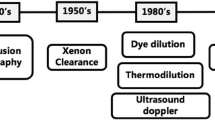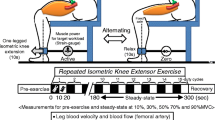Summary
Leg blood flow was studied with the constant infusion dye technique during static exercise of the thigh muscles (quadriceps) and during hand-grips at 15 and 25–30% of MVC.
Blood flow and oxygen uptake in the leg increased in quadriceps exercise and reached their highest values (around 1.2 l/min and 165 ml/min respectively) at 25–30% of MVC, whereas leg vascular resistance decreased. Regional circulatory adaptations and the oxygen uptake — leg blood flow relationship were in close agreement with the responses found in dynamic leg exercise. In view of the marked rise in intramuscular pressure previously observed during quadriceps contractions, a restriction of blood flow and an increased vascular resistance had been expected. Involuntary activation of leg muscles other than the quadriceps may explain the finding.
Contractions of the contralateral quadriceps induced a slight increase in leg blood flow, whereas hand-grips had no influence on blood flow or vascular resistance in the leg. The distribution of the cardiac output during static contractions is discussed, and it is concluded that during hand-grips the increase in blood flow is predominantly distributed to the upper part of the body.
Similar content being viewed by others
References
Barcroft H, Millen JLE (1939) The blood flow through muscle during sustained contraction. J Physiol (Lond) 97: 17–31
Barnes WS (1980) The relationship between maximum isometric strength and intramuscular circulatory occlusion. Ergonomics 23: 351–357
Bonde-Petersen F, Mörk AL, Nielsen E (1975) Local muscle blood flow and sustained contractions of human arm and back muscles. Eur J Appl Physiol 34: 43–50
Clement DL, Pannier JL (1980) Cardiac output distribution during induced static muscular contractions in the dog. Eur J Appl Physiol 45: 199–207
Crayton SC, Aung-Din R, Fixler DE, Mitchell JH (1979) Distribution of cardiac output during induced isometric exercise in dogs. Am J Physiol 236: H218-H224
Edwards RHT, Hill DK, McDonnell MJ (1972) Myothermal and intramuscular pressure measurements in man. J Physiol (Lond) 224: 58–59
Eklund B, Kaijser L, Knutsson E (1974) Blood flow in resting (contralateral) arm and leg during isometric contraction. J Physiol (Lond) 240: 111–124
Gordy E, Drabkin DL (1957) Spectrophotometric studies, XVI. Determination of the oxygen saturation of blood by a simplified technique, applicable to standard equipment. J Biol Chem 227: 285–299
Henriksen O, Nielsen SL, Paaske W (1973) Auto-regulation of blood flow in human adipose tissue. Acta Physiol Scand 89: 531–537
Hohorst HJ (1962) l(+)-Lactat. Bestimmung mit Lactat-Dehydrogenase und DPN. In: Bergmeyer (Hrsg) Methoden der enzymatischen Analyse. Verlag Chemie GMBH, Weinheim, pp 266–270
Humphreys PW, Lind AR (1962) The flow through active and inactive muscles of the forearm during sustained hand-grip contractions. J Physiol (Lond) 166: 120–135
Jorfeldt L, Wahren J (1971) Leg blood flow during exercise in man. Clin Sci 41: 459–473
Kilbom å, Brundin T (1976) Circulatory effects of isometric muscle contractions, performed separately and in combination with dynamic exercise. Eur J Appl Physiol 36: 7–17
Kilbom å, Persson J (1981) Circulatory response to static muscle contractions in three different muscle groups. Clin Physiol 1: 215–225
Lind AR, McNicol GW (1967) Local and central circulatory responses to sustained contractions and the effect of free and restricted arteria inflow on post-exercise hyperaemia. J Physiol (Lond) 192: 573–593
Nelson RR, Gobel FL, Jorgensen CR, Wang K, Wang Y, Taylor HL (1974) Hemodynamic predictors of myocardial oxygen consumption during static and dynamic exercise. Circulation 50: 1179–1189
Rohmert W (1959) Ermittlung von ErholungszuschlÄgen bei statischer Arbeit des Menschen. Diss Techn Hochschule, Aachen
Author information
Authors and Affiliations
Rights and permissions
About this article
Cite this article
Kilbom, å., Persson, J. Leg blood flow during static exercise. Europ. J. Appl. Physiol. 48, 367–377 (1982). https://doi.org/10.1007/BF00430227
Accepted:
Issue Date:
DOI: https://doi.org/10.1007/BF00430227




